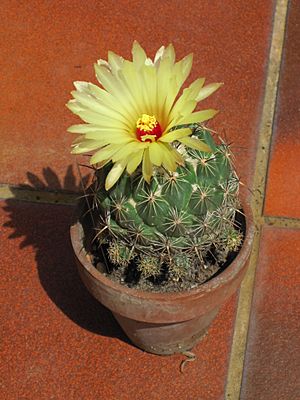Coryphantha facts for kids
Quick facts for kids Coryphantha |
|
|---|---|
 |
|
| Coryphantha ramillosa | |
| Scientific classification | |
| Kingdom: | |
| (unranked): | |
| (unranked): | |
| (unranked): | |
| Order: | |
| Family: | |
| Subfamily: | |
| Tribe: |
Cacteae
|
| Genus: |
Coryphantha
(Engelm.) Lem.
|
| Species | |
|
|
Coryphantha (from Greek, "flowering on the top"), or beehive cactus, is a genus of small to middle-sized, globose or columnar cacti. The genus is native to arid parts of Central America, Mexico, through Arizona, New Mexico, and western Texas and north into southwestern, central, and southeastern Montana. With its two subgenera, 57 species and 20 subspecies, it is one of the largest genera of cactus.
Contents
Description
There are four characteristics that distinguish Coryphantha from other cacti.
- Their bodies do not have ribs, just tubercles.
- The flowers form at the top of the plant (the apex or growing end of the stem).
- The tip (podarium) of each flowering tubercle has three parts, the spiny areole, the groove and the axil. Without the groove it is not a Coryphantha.
- The seed coat (or testa) has a net-like pattern (reticulate).
More than many other cacti, the Coryphantha change in their appearance over their lifespan. The presence or absence of a central spine is not indicative of the genus, even in fully adult plants.
Name
The name Coryphantha was first applied by George Engelmann in 1856 as a subgenus, the earlier name Aulacothele of Lemaire having been abandoned. In 1868 Lemaire promoted the group to genus level. Before this all Coryphantha had been classified as Mammillaria.
Species
- Coryphantha calipensis
- Coryphantha calochlora
- Coryphantha clavata
- Coryphantha compacta (syn. C. palmeri)
- Coryphantha cornifera
- Coryphantha delaetiana
- Coryphantha delicata
- Coryphantha difficilis
- Coryphantha durangensis
- Coryphantha echinoidea
- Coryphantha echinus
- Coryphantha elephantidens
- Coryphantha erecta
- Coryphantha georgii
- Coryphantha glanduligera
- Coryphantha glassii
- Coryphantha gracilis
- Coryphantha grata
- Coryphantha guerkeana
- Coryphantha hintoniorum
- Coryphantha indensis
- Coryphantha jalpanensis
- Coryphantha kracikii
- Coryphantha longicornis
- Coryphantha macromeris
- Coryphantha maiz-tablasensis
- Coryphantha maliterrarum
- Coryphantha melleospina
- Coryphantha neglecta
- Coryphantha nickelsiae
- Coryphantha octacantha
- Coryphantha odorata
- Coryphantha ottonis
- Coryphantha pallida
- Coryphantha poselgeriana
- Coryphantha potosiana
- Coryphantha pseudoechinus
- Coryphantha pseudonickelsiae
- Coryphantha pseudoradians
- Coryphantha pulleineana
- Coryphantha pusilliflora
- Coryphantha pycnacantha
- Coryphantha radians
- Coryphantha ramillosa
- Coryphantha recurvata
- Coryphantha reduncispina
- Coryphantha retusa
- Coryphantha robustispina
- Coryphantha salinensis
- Coryphantha sulcata
- Coryphantha sulcolanata
- Coryphantha tripugionacantha
- Coryphantha unicornis
- Coryphantha vaupeliana
- Coryphantha vogtherriana
- Coryphantha werdermannii
- Coryphantha wohlschlageri
Synonymy
The genus has two valid synonyms:
- Cumarinia Buxb. and
- Lepidocoryphantha Backeb.
and three invalid ones:
- Aulacothele Monv. (nom. inval.)
- Glandulifera (Salm-Dyck) Fric (nom. inval.)
- Roseia Fric (nom. inval.)
Related genera
A number of Coryphantha have previously been classified in other genera, indeed the type species C. sulcata was originally named Mammillaria sulcata Other examples include Echinocactus salinensis Poselger 1853 now Coryphantha salinensis (Poselger) Dicht and A.Lüthy 1998 and Neolloydia pulleineana Blackberg 1948 now Coryphantha pulleineana (Blackberg) Glass 1968.
Similarly, a number of other species have been previously classified as Coryphantha. For example, Escobaria vivipara was called Coryphantha vivipara.
See also
 In Spanish: Coryphantha para niños
In Spanish: Coryphantha para niños





